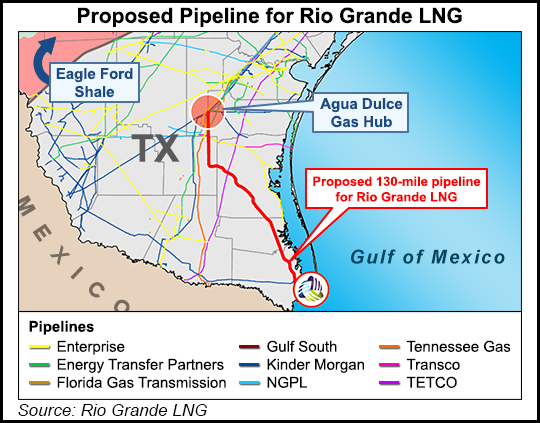Regulatory | Infrastructure | LNG | LNG Insight | NGI All News Access | NGI The Weekly Gas Market Report
DOE Approves LNG Exports from Four Proposed Texas Projects
The U.S. Department of Energy (DOE) issued four long-term orders Monday authorizing exports of domestically produced liquefied natural gas (LNG) from a quartet of proposed projects in Texas.

In separate orders, DOE authorized three export project proposals in the Brownsville area, which is on the southern tip of the state — Annova LNG Common Infrastructure LLC for 0.99 Bcf/d, Rio Grande LNG LLC for 3.61 Bcf/d and Texas LNG Brownsville LLC for 0.56 Bcf/d. Corpus Christi Liquefaction Stage III LLC also was authorized to export 1.59 Bcf/d as part of Cheniere Energy Inc.’s proposed expansion in South Texas.
The entities “are authorized to export LNG from their respective projects by ocean-going vessel to any country with which the United States does not have a free trade agreement [FTA] requiring national treatment for trade in natural gas, and with which trade is not prohibited by U.S. law or policy,” DOE said.
The export capacity of the four projects is enough LNG to supply more than half of Europe’s import demand, according to Secretary of Energy Dan Brouillette.
“In Europe, as much as anywhere in the world, energy security is, in fact, national security, and energy security depends upon energy diversity,” Brouillette said Monday at the Atlantic Council in Washington, DC. “The fact is, and it remains, that many European countries are dependent on Russian gas to meet more than 75% of their annual gas imports, and given Russia’s use of energy to bend other nations to its will, those nations must diversify.
“Thankfully, I think the United States is offering a compelling answer: greater energy choice for Europe through our LNG exports, and we’re not limiting their choices to U.S. LNG.”
DOE’s approvals come three months after FERC authorized the siting, construction, and operation of the export projects. The Federal Energy Regulatory Commission approved Texas LNG Brownsville’s proposal for a 4 million metric ton/year (mmty) terminal on the Brownsville Ship Channel in Cameron County, TX [CP16-116]. FERC also approved Rio Grande LNG and the Rio Bravo Pipeline’s proposal for an export terminal to be built on a 1,000-acre industrial site in Cameron County at the Port of Brownsville [CP16-454, CP16-455].
In addition, FERC approved Houston-based Annova’s proposal to construct an LNG export terminal to include six liquefaction trains, each with a nameplate capacity of 1 mmty, for an aggregate nameplate capacity of 6 mmty and a maximum output at optimal operating conditions of 6.95 mmty on the Brownsville Ship Channel [CP16-480]. And FERC approved Cheniere’s request to build a third train at the Corpus Christi export project [CP18-512].
The approvals were positive news for the U.S. LNG industry, according to The Center for LNG.
“As the global LNG market races to bring more supply to market, this decision helps ensure that U.S. LNG projects are not unnecessarily delayed and can compete for the growing global market,” said Executive Director Charlie Riedl.
Riedl also commended a proposal by DOE, published in the Federal Register on Tuesday, that would extend natural gas export authorizations to non-FTA countries through 2050.
The proposed policy statement would extend the standard 20-year term for gas export authorizations, including domestically produced LNG, compressed natural gas and compressed gas liquid, from the Lower 48 states. If approved, the policy would allow existing non-FTA authorization holders to apply to extend their export terms through Dec. 31, 2050, on a voluntary opt-in basis. DOE is accepting comments on the proposed policy through March 12.
© 2024 Natural Gas Intelligence. All rights reserved.
ISSN © 1532-1231 | ISSN © 2577-9877 | ISSN © 1532-1266 |
